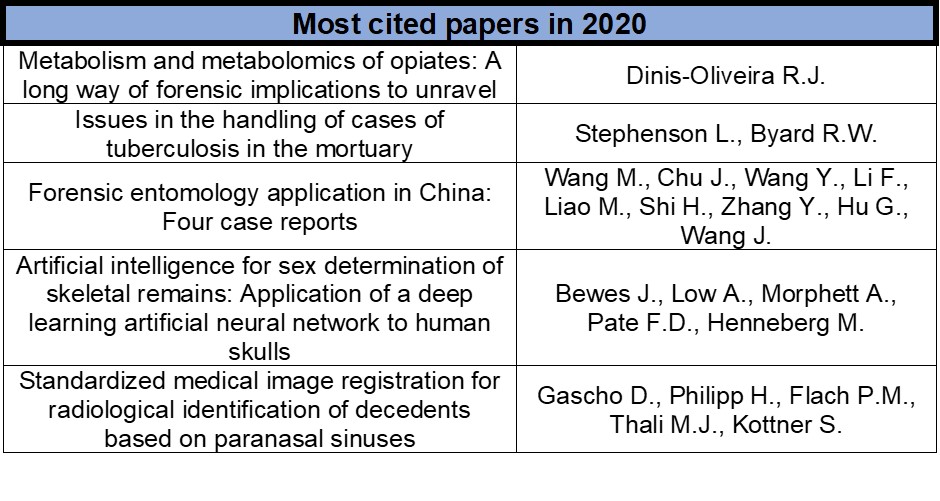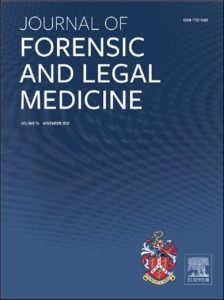Look. I don’t want to do this. You don’t want me to do this. But we have no choice. It’s the New Year, and as such I am compelled to write some sort of ‘year in review’ type reflective piece. Especially since the year in question is 2020 and has been so, well, you know… So let’s just get on with it, shall we?
This was my second full year in the Journal of Forensic and Legal Medicine hot-seat. I started as Editor-in-Chief in Jan 2019 following some time as an Associate Editor. I’d always had a soft-spot for JFLM, and after 3 years as E-i-C of Science & Justice I realised how much I had enjoyed this work. JFLM was a significantly larger journal working in a different forensic discipline with a professional body I’d only really had dealings with tangentially – the allure was too much. I like to move fast when I’m put in charge of something, so immediately started work on the back-of-house processes and focusing the remit of the Journal. Years of playing Football Manager has taught me the importance of addressing key problem areas and mapping out a vision of what you’re about. Which is why I always shift my teams from the inevitable flat-back four to three at the back – even if you have poor defenders, you’ll usually end up with one extra player available to stop attacks and a flexible 3-5-2 formation allows for easier movement of the ball from the back. Basically it stops you shipping goals so much while you work on the rest of the team. I concede that that’s a lot of unnecessary detail for non-FM players, but you can see where I’m coming from…
Now as you know, I’m not one to blow my own trumpet (no, I didn’t believe this as I typed it either…), but the Journal has just had it’s most successful year in its illustrious history. The publication field is really competitive now, with an increasing number of journals appearing and accepting manuscripts. In the forensic field, we’ve seen FSI: Mind and Law as well as FSI: Animals and Environments make an appearance, FSI: Synergy, the Australian Journal of Forensic Sciences and Forensic Anthropology go from strength-to-strength, while Forensic Science International and the International Journal of Legal Medicine continue to be big hitters, as, of course does the mighty Journal of Forensic Sciences. So any improvement within this context is something to be celebrated. For me, the key measure is whether the Journal is making a substantial contribution to the field – otherwise, what’s the point? Whenever I lead something, I’m not really interested in being good, I’m interested in being the best. I’m quietly competitive, frankly, but manage to hide it well… It’s really hard to measure a Journal’s impact though, but the best I have at my fingertips are metrics on submission numbers (which suggests how attractive we are), downloads (which suggests how interesting we are), and citations (a crude measure of impact). In addition, I’m interested in things such as handling speed (which tells us something about our backroom processes) and Rejection Rate (which tells us something about how we’re filtering those submissions), the geographical origins of those who are submitting and having work published, and the gender profile of our authors.
Thankfully, I get regular reports from the publisher with all of this data inside. It’s like a data treasure trove, but the chest is a bar chart. I really do love a nice data visualisation. We have a paper in peer review at the moment which undertook a bibliometric network analysis and presented the outputs in a beautiful and colourful VOSviewer diagram. It was so becoming I almost swooned like a debutante attending her first season’s summer ball in Bridgerton.
We’re currently running at over 2 manuscript submissions a day, which is about a 30% increase since I took over the reigns. We’ve had more submissions in 2020 than in any year previously, and this is so exciting to see. What’s more, the range of topics we see continues to be broad and varied. We’ve worked very hard over the past couple of years to improve the visibility of the Journal and our papers, including a better use of social media, introduction of timely Commentaries, and promoting a regular Editor’s Choice. Most recently we’ve drawn together Online Topical Collections on Custody and Detention and Forensic Toxicology. As our visibility improved, we saw a sharp increase in more significant submissions.
Now related to this increase in submissions is an increase in our Rejection Rate, which now sits at around 83%. This is high for the forensic journals (we used to be about 70%), but reflects both the response to our increased submission volume (the number of papers we publish has remained the same despite this increase) as well as a tougher approach to our remit. This latter point is important – it’s a crowded market, and it’s important that we can carve out a niche for ourselves, and for the Faculty of Forensic & Legal Medicine, who we represent.
Despite this increase in work, our average speed for final decisions (so that’s at desk, first decision and then final editorial outcome) have all dropped. We’re the fastest we’ve been in years now, which is testament to the brilliant work and support of our peer reviewers and our Associate Editors Dr Wilma Duijst and Dr Maria Nittis. We’re able to divide the workload based on our subject expertise and it works really well. When I was Editor of Science & Justice, I used to run the journal like a dictatorship, albeit a friendly dictatorship. Experience has me working much more effectively in a team where I’ve been able to appoint colleagues with complementary but different knowledge and approaches.
Personally, I am delighted that our citations have gone up dramatically over the past couple of years. I mean, it’s not that ending to Season 2 of The Mandalorian delighted, but our citation count is over double what it was in 2015. It’s a sign that we’re publishing higher quality and more important work. This means that our IF has gone up steadily too, and we’re now 9th out of 16 in the ‘Medicine, Legal’ category. But we’re just behind JFS, and that competitive streak of mine wants to catch them. I’ve presented our Top 5 cited papers in 2020 below, and as you can see, the range of topics is quite broad (which, as someone whose research is quite interdisciplinary, I quite like):
 Someone, somewhere is reading one of our published papers every 2 minutes. Which is incredible. Over a quarter of a million reads in a year is a huge achievement. It’s really interesting to think about our global footprint in this regard. Only 32% of our engagement comes from the US and UK, with the rest of the world soaking up the Journal in increasing numbers. For me, this makes a real change from working on Science & Justice, which was so much more European in scope.. This is also reflected in where our overall manuscript submissions are from, and I’ve presented some of the data for 2020 below:
Someone, somewhere is reading one of our published papers every 2 minutes. Which is incredible. Over a quarter of a million reads in a year is a huge achievement. It’s really interesting to think about our global footprint in this regard. Only 32% of our engagement comes from the US and UK, with the rest of the world soaking up the Journal in increasing numbers. For me, this makes a real change from working on Science & Justice, which was so much more European in scope.. This is also reflected in where our overall manuscript submissions are from, and I’ve presented some of the data for 2020 below:
 We’ve got work to do to address the fact that a significant number of submissions from some countries are not getting through our peer review process. Some of this is simply due to poor disciplinary fit (we get lots of submissions about DNA profiling, which we don’t really publish), but we want to work with colleagues across our readership to support quality research and dissemination (while recognising the wider publication context we are working in). Nonetheless, we have been able to increase the number of countries that we have accepted articles from, which gives JFLM an increasingly international feel and significance.
We’ve got work to do to address the fact that a significant number of submissions from some countries are not getting through our peer review process. Some of this is simply due to poor disciplinary fit (we get lots of submissions about DNA profiling, which we don’t really publish), but we want to work with colleagues across our readership to support quality research and dissemination (while recognising the wider publication context we are working in). Nonetheless, we have been able to increase the number of countries that we have accepted articles from, which gives JFLM an increasingly international feel and significance.
Can I claim all the credit for this wonderful success? My Elsevier Handler, Alex, would very insistently say “No”. But he’s not here right now, so let’s just agree that I’m a leadership genius and ask no further questions…

